Research Analysis Report: Communication in Two Organizations
VerifiedAdded on 2020/11/23
|13
|2494
|286
Report
AI Summary
This report presents a research analysis of communication networks within two distinct Australian organizations. The first part utilizes a map view to depict communication patterns among employees, identifying key clusters to facilitate the sharing of tacit data via email, particularly for research and development teams. The second section interprets a Leximancer analysis of face-to-face interviews conducted with management and field staff of a service-based organization, evaluating the level of service support provided by employees. The report includes an executive summary, introduction, detailed discussions of both sections, recommendations for improving communication strategies, and a conclusion. The analysis emphasizes the importance of identifying key communicators, leveraging group-based communication technologies, and enhancing customer-manager interactions to improve overall organizational effectiveness and customer satisfaction. The report provides a comprehensive overview of communication dynamics and offers actionable insights for organizational improvement.
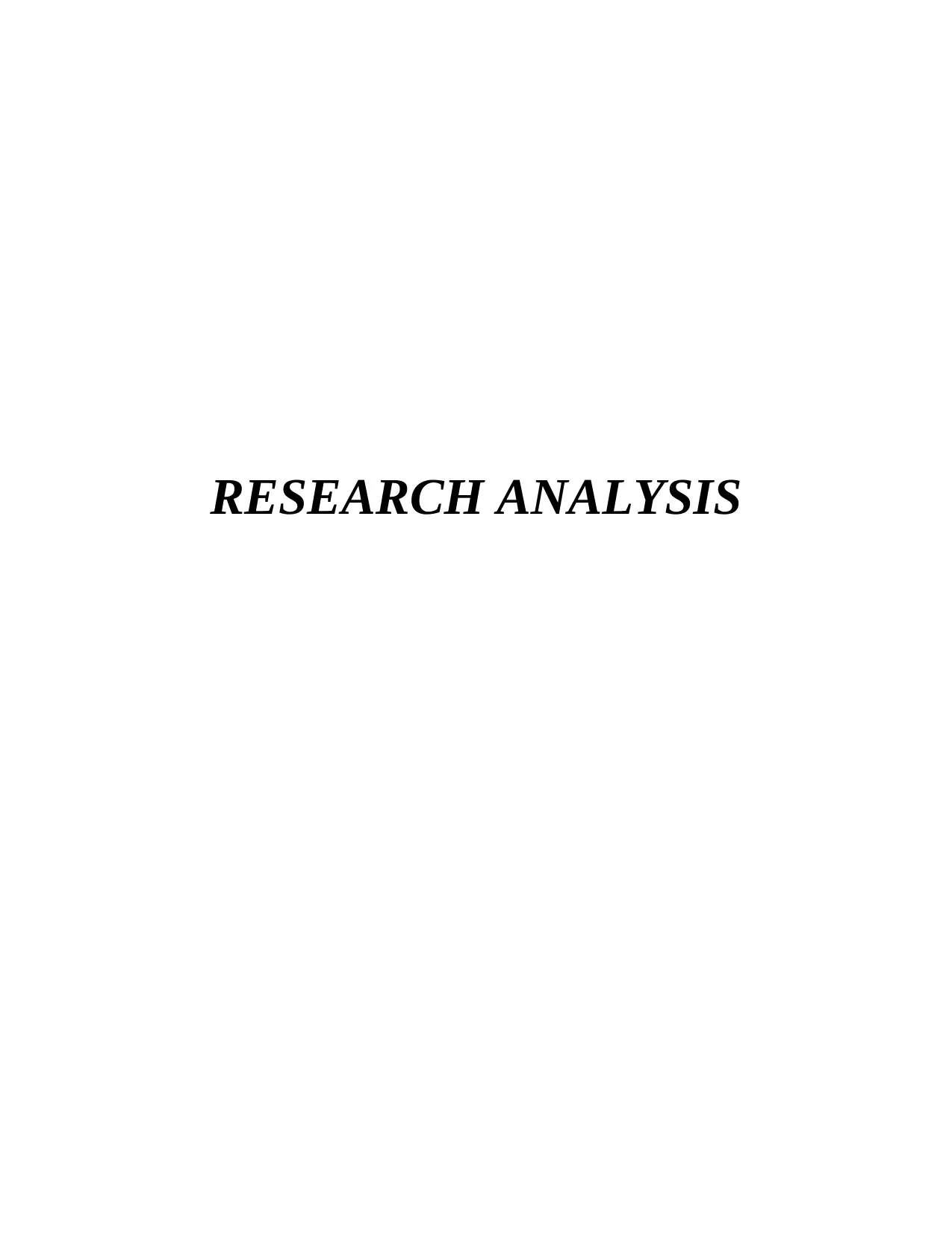
RESEARCH ANALYSIS
Paraphrase This Document
Need a fresh take? Get an instant paraphrase of this document with our AI Paraphraser

EXECUTIVE SUMMARY
Research analysis is based on communication in two different Australian organisation.
The section a discussion is based on map view which reflect communication network among
employee firm via email from which six different clusters are identified to determine key
members for board meeting to share tacit data that is codified information which can ne
communicated via email. The clusters are formed to derive relevant Research and development
and design staff members which will make use of group-based communication technology
system of supporting meeting with other employee. On the other hand, discussion is
interpretation of Leximancer process of analysis which was based on face to face interview of
management and filed staff members of service based organisation to evaluate level of service
support enable by employee of firm.
Research analysis is based on communication in two different Australian organisation.
The section a discussion is based on map view which reflect communication network among
employee firm via email from which six different clusters are identified to determine key
members for board meeting to share tacit data that is codified information which can ne
communicated via email. The clusters are formed to derive relevant Research and development
and design staff members which will make use of group-based communication technology
system of supporting meeting with other employee. On the other hand, discussion is
interpretation of Leximancer process of analysis which was based on face to face interview of
management and filed staff members of service based organisation to evaluate level of service
support enable by employee of firm.

Table of Contents
EXECUTIVE SUMMARY.............................................................................................................2
INTRODUCTION...........................................................................................................................1
MAIN BODY...................................................................................................................................1
DISCUSSION OF SECTION A......................................................................................................1
.........................................................................................................................................................2
DISCUSSION OF SECTION B......................................................................................................4
RECOMMENDATION...................................................................................................................5
CONCLUSION................................................................................................................................6
REFERENCES................................................................................................................................7
APPENDIX......................................................................................................................................8
Scenario A...................................................................................................................................8
Scenario B...................................................................................................................................8
EXECUTIVE SUMMARY.............................................................................................................2
INTRODUCTION...........................................................................................................................1
MAIN BODY...................................................................................................................................1
DISCUSSION OF SECTION A......................................................................................................1
.........................................................................................................................................................2
DISCUSSION OF SECTION B......................................................................................................4
RECOMMENDATION...................................................................................................................5
CONCLUSION................................................................................................................................6
REFERENCES................................................................................................................................7
APPENDIX......................................................................................................................................8
Scenario A...................................................................................................................................8
Scenario B...................................................................................................................................8
⊘ This is a preview!⊘
Do you want full access?
Subscribe today to unlock all pages.

Trusted by 1+ million students worldwide

INTRODUCTION
Research analysis is based on discussion of findings which are outlined from particular
data collection phenomenon. Business decision analytics is crucial concern of business and assist
the organisation in determining pros and cons of very organisational situation. The assessment is
based on two different discussion where one section is base on communication between staff
members of mid sized Australian organisation which, consist of 800 people and the firm is
planning to make use of group based communication technology, for which key members of the
different communication group will be chosen. The discussion of section B is based on service
based organisation of Australian which have conducted face to face interview of management
and field staff which will be analysed with the help of Leximancer process of analysis.
MAIN BODY
Discussion of section a
In accordance with map view it is determined that majority of staff members in
organisation are interconnected which demonstrate communication changing in organisation. It
is important for the research development and design team to outline clusters which are
connected in proper line of connection because it will assist in deriving key members which
regulates communication among all employees of organisation (Thomas, 2014). In accordance
with research and development and design department tacit data is encrypted data which cannot
exchanged via e- mail therefore there is need of making group based communication technology
to support meetings of explicit information. In accordance with R&D and design team the key
members of different clusters are 78, 39, 19, 10, 59 and 66. These are the employee which are
viable for managing explicit information and logical information of company. Analysing key
members is important because tacit data can be exchanged via mail because of two concerns that
is information is confidential and also have coded data of firm. The tangled nodes of staff
denotes complex communication among staff from which analysing key clusters and staff is
important for managing effective interaction of codified information.
In accordance with connectivity of Nodes, 6 viable clusters are identified which are
outlined in table with nodes from all 6 clusters.
Serial
Number
Clusters Nodes from each clusters
1
Research analysis is based on discussion of findings which are outlined from particular
data collection phenomenon. Business decision analytics is crucial concern of business and assist
the organisation in determining pros and cons of very organisational situation. The assessment is
based on two different discussion where one section is base on communication between staff
members of mid sized Australian organisation which, consist of 800 people and the firm is
planning to make use of group based communication technology, for which key members of the
different communication group will be chosen. The discussion of section B is based on service
based organisation of Australian which have conducted face to face interview of management
and field staff which will be analysed with the help of Leximancer process of analysis.
MAIN BODY
Discussion of section a
In accordance with map view it is determined that majority of staff members in
organisation are interconnected which demonstrate communication changing in organisation. It
is important for the research development and design team to outline clusters which are
connected in proper line of connection because it will assist in deriving key members which
regulates communication among all employees of organisation (Thomas, 2014). In accordance
with research and development and design department tacit data is encrypted data which cannot
exchanged via e- mail therefore there is need of making group based communication technology
to support meetings of explicit information. In accordance with R&D and design team the key
members of different clusters are 78, 39, 19, 10, 59 and 66. These are the employee which are
viable for managing explicit information and logical information of company. Analysing key
members is important because tacit data can be exchanged via mail because of two concerns that
is information is confidential and also have coded data of firm. The tangled nodes of staff
denotes complex communication among staff from which analysing key clusters and staff is
important for managing effective interaction of codified information.
In accordance with connectivity of Nodes, 6 viable clusters are identified which are
outlined in table with nodes from all 6 clusters.
Serial
Number
Clusters Nodes from each clusters
1
Paraphrase This Document
Need a fresh take? Get an instant paraphrase of this document with our AI Paraphraser

1 07, 30,32 (07, 80) (07,59) (07,19) (07, 26) (32, 12) (32,53) (32,29)
(30,15) (30, 80)
2 40, 74,39 (39,42) (39,14) (74,59) (74,78) (74,75) (40,84) (40,78)
(40,35) (40,19) (40,73)
3 40, 74,39, 19, 14 (74,59) (74,78) (74,75) (40,74) (40,73) (40,85) (39,52)
(39,40) (39,14) (19,07) (19, 61)
4 72, 69, 38 (38,72) (38,69)
5 14, 41, 13 (14,36) (14,39) (14,19)
6 75, 27, 67 (75,59) (75,54) (75,15) (75, 74)
Key member of each cluster
Clusters Key members of clusters
1 19, 78
2 39, 40
3 15, 07
4 69, 38
5 36, 14
6 74, 75
Rooms Clusters Key members for R & D
and design meetings
A 1 19, 78
B 2 39, 40
C 3 15, 07
D 4 69, 38
2
(30,15) (30, 80)
2 40, 74,39 (39,42) (39,14) (74,59) (74,78) (74,75) (40,84) (40,78)
(40,35) (40,19) (40,73)
3 40, 74,39, 19, 14 (74,59) (74,78) (74,75) (40,74) (40,73) (40,85) (39,52)
(39,40) (39,14) (19,07) (19, 61)
4 72, 69, 38 (38,72) (38,69)
5 14, 41, 13 (14,36) (14,39) (14,19)
6 75, 27, 67 (75,59) (75,54) (75,15) (75, 74)
Key member of each cluster
Clusters Key members of clusters
1 19, 78
2 39, 40
3 15, 07
4 69, 38
5 36, 14
6 74, 75
Rooms Clusters Key members for R & D
and design meetings
A 1 19, 78
B 2 39, 40
C 3 15, 07
D 4 69, 38
2
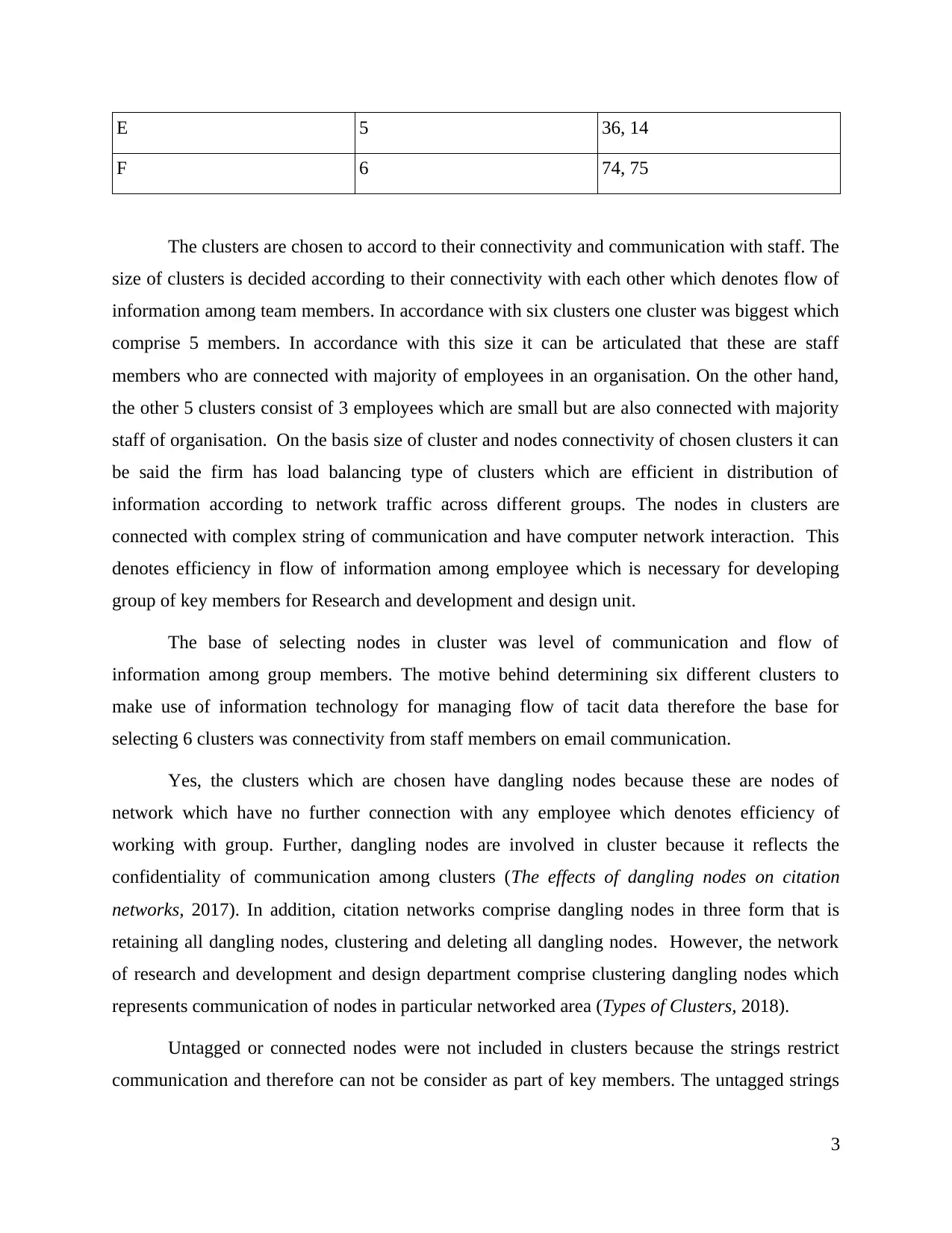
E 5 36, 14
F 6 74, 75
The clusters are chosen to accord to their connectivity and communication with staff. The
size of clusters is decided according to their connectivity with each other which denotes flow of
information among team members. In accordance with six clusters one cluster was biggest which
comprise 5 members. In accordance with this size it can be articulated that these are staff
members who are connected with majority of employees in an organisation. On the other hand,
the other 5 clusters consist of 3 employees which are small but are also connected with majority
staff of organisation. On the basis size of cluster and nodes connectivity of chosen clusters it can
be said the firm has load balancing type of clusters which are efficient in distribution of
information according to network traffic across different groups. The nodes in clusters are
connected with complex string of communication and have computer network interaction. This
denotes efficiency in flow of information among employee which is necessary for developing
group of key members for Research and development and design unit.
The base of selecting nodes in cluster was level of communication and flow of
information among group members. The motive behind determining six different clusters to
make use of information technology for managing flow of tacit data therefore the base for
selecting 6 clusters was connectivity from staff members on email communication.
Yes, the clusters which are chosen have dangling nodes because these are nodes of
network which have no further connection with any employee which denotes efficiency of
working with group. Further, dangling nodes are involved in cluster because it reflects the
confidentiality of communication among clusters (The effects of dangling nodes on citation
networks, 2017). In addition, citation networks comprise dangling nodes in three form that is
retaining all dangling nodes, clustering and deleting all dangling nodes. However, the network
of research and development and design department comprise clustering dangling nodes which
represents communication of nodes in particular networked area (Types of Clusters, 2018).
Untagged or connected nodes were not included in clusters because the strings restrict
communication and therefore can not be consider as part of key members. The untagged strings
3
F 6 74, 75
The clusters are chosen to accord to their connectivity and communication with staff. The
size of clusters is decided according to their connectivity with each other which denotes flow of
information among team members. In accordance with six clusters one cluster was biggest which
comprise 5 members. In accordance with this size it can be articulated that these are staff
members who are connected with majority of employees in an organisation. On the other hand,
the other 5 clusters consist of 3 employees which are small but are also connected with majority
staff of organisation. On the basis size of cluster and nodes connectivity of chosen clusters it can
be said the firm has load balancing type of clusters which are efficient in distribution of
information according to network traffic across different groups. The nodes in clusters are
connected with complex string of communication and have computer network interaction. This
denotes efficiency in flow of information among employee which is necessary for developing
group of key members for Research and development and design unit.
The base of selecting nodes in cluster was level of communication and flow of
information among group members. The motive behind determining six different clusters to
make use of information technology for managing flow of tacit data therefore the base for
selecting 6 clusters was connectivity from staff members on email communication.
Yes, the clusters which are chosen have dangling nodes because these are nodes of
network which have no further connection with any employee which denotes efficiency of
working with group. Further, dangling nodes are involved in cluster because it reflects the
confidentiality of communication among clusters (The effects of dangling nodes on citation
networks, 2017). In addition, citation networks comprise dangling nodes in three form that is
retaining all dangling nodes, clustering and deleting all dangling nodes. However, the network
of research and development and design department comprise clustering dangling nodes which
represents communication of nodes in particular networked area (Types of Clusters, 2018).
Untagged or connected nodes were not included in clusters because the strings restrict
communication and therefore can not be consider as part of key members. The untagged strings
3
⊘ This is a preview!⊘
Do you want full access?
Subscribe today to unlock all pages.

Trusted by 1+ million students worldwide
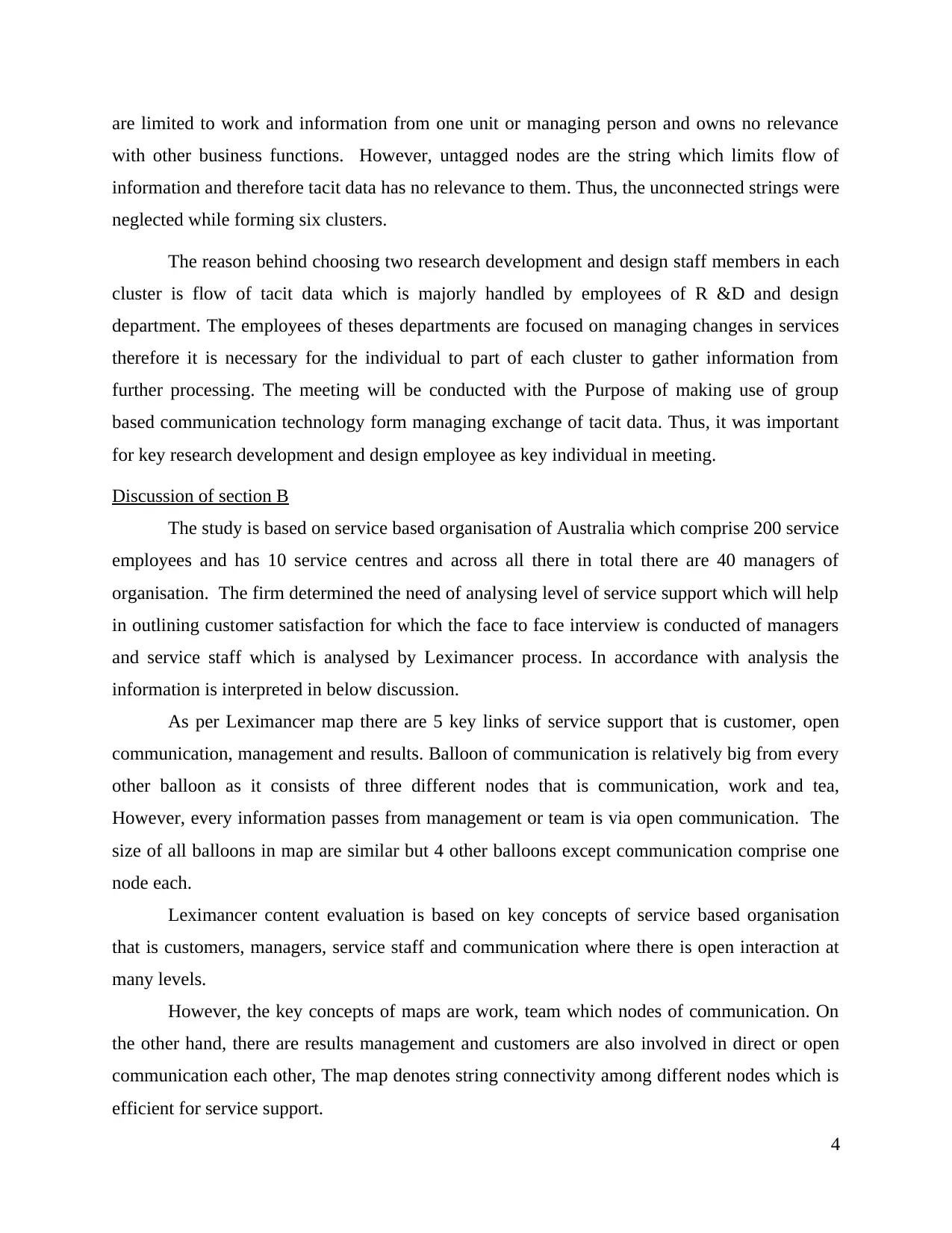
are limited to work and information from one unit or managing person and owns no relevance
with other business functions. However, untagged nodes are the string which limits flow of
information and therefore tacit data has no relevance to them. Thus, the unconnected strings were
neglected while forming six clusters.
The reason behind choosing two research development and design staff members in each
cluster is flow of tacit data which is majorly handled by employees of R &D and design
department. The employees of theses departments are focused on managing changes in services
therefore it is necessary for the individual to part of each cluster to gather information from
further processing. The meeting will be conducted with the Purpose of making use of group
based communication technology form managing exchange of tacit data. Thus, it was important
for key research development and design employee as key individual in meeting.
Discussion of section B
The study is based on service based organisation of Australia which comprise 200 service
employees and has 10 service centres and across all there in total there are 40 managers of
organisation. The firm determined the need of analysing level of service support which will help
in outlining customer satisfaction for which the face to face interview is conducted of managers
and service staff which is analysed by Leximancer process. In accordance with analysis the
information is interpreted in below discussion.
As per Leximancer map there are 5 key links of service support that is customer, open
communication, management and results. Balloon of communication is relatively big from every
other balloon as it consists of three different nodes that is communication, work and tea,
However, every information passes from management or team is via open communication. The
size of all balloons in map are similar but 4 other balloons except communication comprise one
node each.
Leximancer content evaluation is based on key concepts of service based organisation
that is customers, managers, service staff and communication where there is open interaction at
many levels.
However, the key concepts of maps are work, team which nodes of communication. On
the other hand, there are results management and customers are also involved in direct or open
communication each other, The map denotes string connectivity among different nodes which is
efficient for service support.
4
with other business functions. However, untagged nodes are the string which limits flow of
information and therefore tacit data has no relevance to them. Thus, the unconnected strings were
neglected while forming six clusters.
The reason behind choosing two research development and design staff members in each
cluster is flow of tacit data which is majorly handled by employees of R &D and design
department. The employees of theses departments are focused on managing changes in services
therefore it is necessary for the individual to part of each cluster to gather information from
further processing. The meeting will be conducted with the Purpose of making use of group
based communication technology form managing exchange of tacit data. Thus, it was important
for key research development and design employee as key individual in meeting.
Discussion of section B
The study is based on service based organisation of Australia which comprise 200 service
employees and has 10 service centres and across all there in total there are 40 managers of
organisation. The firm determined the need of analysing level of service support which will help
in outlining customer satisfaction for which the face to face interview is conducted of managers
and service staff which is analysed by Leximancer process. In accordance with analysis the
information is interpreted in below discussion.
As per Leximancer map there are 5 key links of service support that is customer, open
communication, management and results. Balloon of communication is relatively big from every
other balloon as it consists of three different nodes that is communication, work and tea,
However, every information passes from management or team is via open communication. The
size of all balloons in map are similar but 4 other balloons except communication comprise one
node each.
Leximancer content evaluation is based on key concepts of service based organisation
that is customers, managers, service staff and communication where there is open interaction at
many levels.
However, the key concepts of maps are work, team which nodes of communication. On
the other hand, there are results management and customers are also involved in direct or open
communication each other, The map denotes string connectivity among different nodes which is
efficient for service support.
4
Paraphrase This Document
Need a fresh take? Get an instant paraphrase of this document with our AI Paraphraser

Field service staff of the organisation make use of open communication with customers
where there is direct communication of service staff with managers.
Nodes connectivity denotes interaction and basis of communication from where it can be
articulated that Service staff communicates with managers on the basis of results. However,
results are also discussed by managers with team workers. On the other hand team and work is
also discussed with customers in order to make them believe on services of business.
No there is not high level of communication between managers and customer because
customers are linked with nodes of team and work, from where it can be said that there is direct
communication between managers and consumer but there is minimum level of communication
among management and buyers.
Support availability is important because it denotes stakeholder satisfaction from services
of business. In accordance with Leximancer map, it is demonstrated that support service are
effective of company because there are nodes of work and team are connected with customer via
open communication. In accordance with strings of nodes it denotes that communication
between service staff and manger is not open but direct where interaction occurs on the basis of
work and results.
Communication of results by service staff is based on clustering dangling nodes which
are not further linked but have internal communication which finally communicated via service
staff to management from where it can be articulated that nature of communication is verbal and
visual.
The Leximancer concept map denotes that results are communicated in cluster of work
and team and then finally communicated to customer via open interaction from which it can be
said that management play a vital role in open communication of results to customers of services.
The concept map denotes efficient of service staff and managers of organisation in managing
service support and customer satisfaction.
RECOMMENDATION
Discussion A and B both are focused on communication network of two different
organisation in section A interconnectivity and communication is reviewed by map where
interconnectivity between nodes is demonstrated. The connectivity of nodes reflect string of
communication among employee. However, section B was based on Leximancer process
analysis which was done of face to face interview of manage and staff members of service based
5
where there is direct communication of service staff with managers.
Nodes connectivity denotes interaction and basis of communication from where it can be
articulated that Service staff communicates with managers on the basis of results. However,
results are also discussed by managers with team workers. On the other hand team and work is
also discussed with customers in order to make them believe on services of business.
No there is not high level of communication between managers and customer because
customers are linked with nodes of team and work, from where it can be said that there is direct
communication between managers and consumer but there is minimum level of communication
among management and buyers.
Support availability is important because it denotes stakeholder satisfaction from services
of business. In accordance with Leximancer map, it is demonstrated that support service are
effective of company because there are nodes of work and team are connected with customer via
open communication. In accordance with strings of nodes it denotes that communication
between service staff and manger is not open but direct where interaction occurs on the basis of
work and results.
Communication of results by service staff is based on clustering dangling nodes which
are not further linked but have internal communication which finally communicated via service
staff to management from where it can be articulated that nature of communication is verbal and
visual.
The Leximancer concept map denotes that results are communicated in cluster of work
and team and then finally communicated to customer via open interaction from which it can be
said that management play a vital role in open communication of results to customers of services.
The concept map denotes efficient of service staff and managers of organisation in managing
service support and customer satisfaction.
RECOMMENDATION
Discussion A and B both are focused on communication network of two different
organisation in section A interconnectivity and communication is reviewed by map where
interconnectivity between nodes is demonstrated. The connectivity of nodes reflect string of
communication among employee. However, section B was based on Leximancer process
analysis which was done of face to face interview of manage and staff members of service based
5
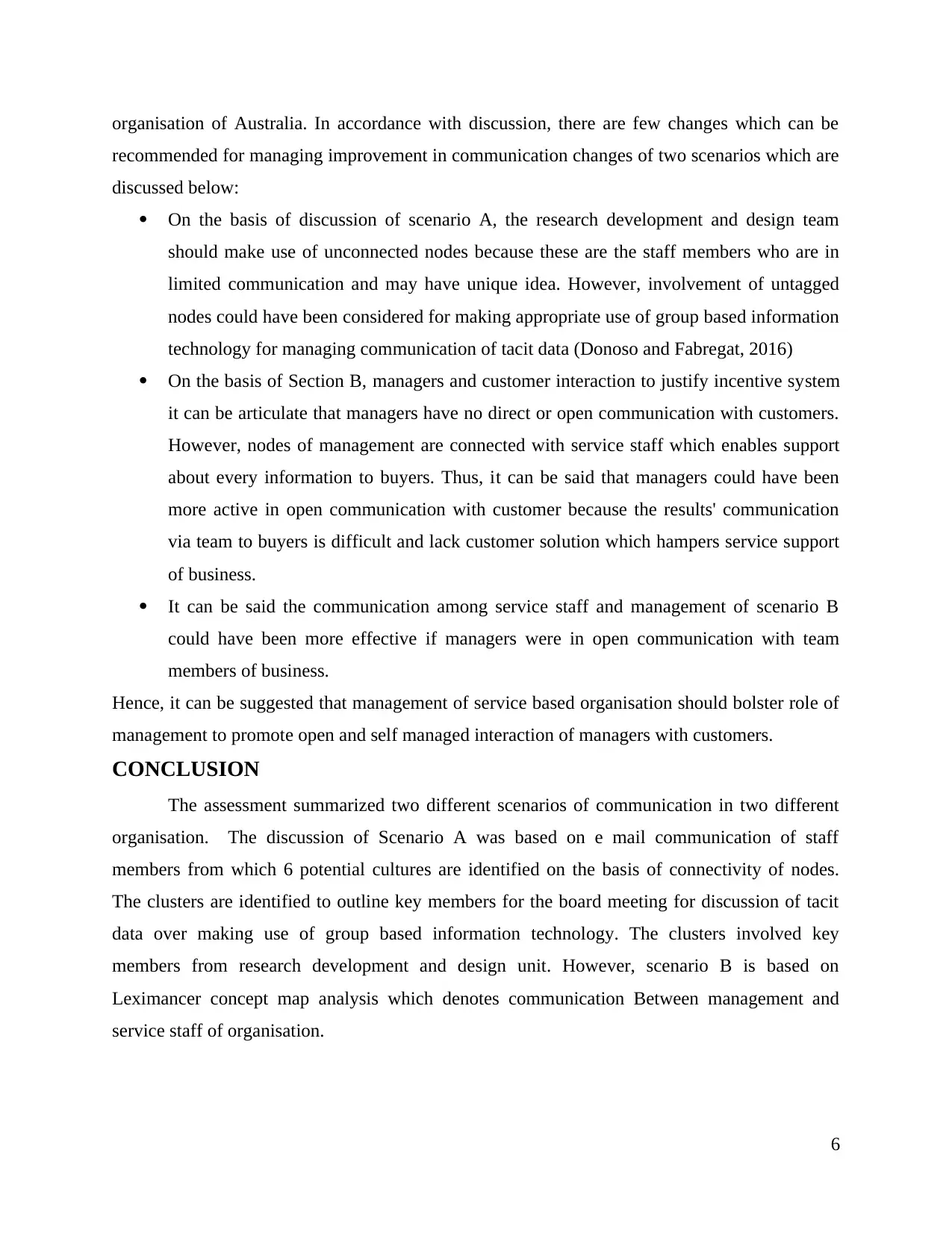
organisation of Australia. In accordance with discussion, there are few changes which can be
recommended for managing improvement in communication changes of two scenarios which are
discussed below:
On the basis of discussion of scenario A, the research development and design team
should make use of unconnected nodes because these are the staff members who are in
limited communication and may have unique idea. However, involvement of untagged
nodes could have been considered for making appropriate use of group based information
technology for managing communication of tacit data (Donoso and Fabregat, 2016)
On the basis of Section B, managers and customer interaction to justify incentive system
it can be articulate that managers have no direct or open communication with customers.
However, nodes of management are connected with service staff which enables support
about every information to buyers. Thus, it can be said that managers could have been
more active in open communication with customer because the results' communication
via team to buyers is difficult and lack customer solution which hampers service support
of business.
It can be said the communication among service staff and management of scenario B
could have been more effective if managers were in open communication with team
members of business.
Hence, it can be suggested that management of service based organisation should bolster role of
management to promote open and self managed interaction of managers with customers.
CONCLUSION
The assessment summarized two different scenarios of communication in two different
organisation. The discussion of Scenario A was based on e mail communication of staff
members from which 6 potential cultures are identified on the basis of connectivity of nodes.
The clusters are identified to outline key members for the board meeting for discussion of tacit
data over making use of group based information technology. The clusters involved key
members from research development and design unit. However, scenario B is based on
Leximancer concept map analysis which denotes communication Between management and
service staff of organisation.
6
recommended for managing improvement in communication changes of two scenarios which are
discussed below:
On the basis of discussion of scenario A, the research development and design team
should make use of unconnected nodes because these are the staff members who are in
limited communication and may have unique idea. However, involvement of untagged
nodes could have been considered for making appropriate use of group based information
technology for managing communication of tacit data (Donoso and Fabregat, 2016)
On the basis of Section B, managers and customer interaction to justify incentive system
it can be articulate that managers have no direct or open communication with customers.
However, nodes of management are connected with service staff which enables support
about every information to buyers. Thus, it can be said that managers could have been
more active in open communication with customer because the results' communication
via team to buyers is difficult and lack customer solution which hampers service support
of business.
It can be said the communication among service staff and management of scenario B
could have been more effective if managers were in open communication with team
members of business.
Hence, it can be suggested that management of service based organisation should bolster role of
management to promote open and self managed interaction of managers with customers.
CONCLUSION
The assessment summarized two different scenarios of communication in two different
organisation. The discussion of Scenario A was based on e mail communication of staff
members from which 6 potential cultures are identified on the basis of connectivity of nodes.
The clusters are identified to outline key members for the board meeting for discussion of tacit
data over making use of group based information technology. The clusters involved key
members from research development and design unit. However, scenario B is based on
Leximancer concept map analysis which denotes communication Between management and
service staff of organisation.
6
⊘ This is a preview!⊘
Do you want full access?
Subscribe today to unlock all pages.

Trusted by 1+ million students worldwide
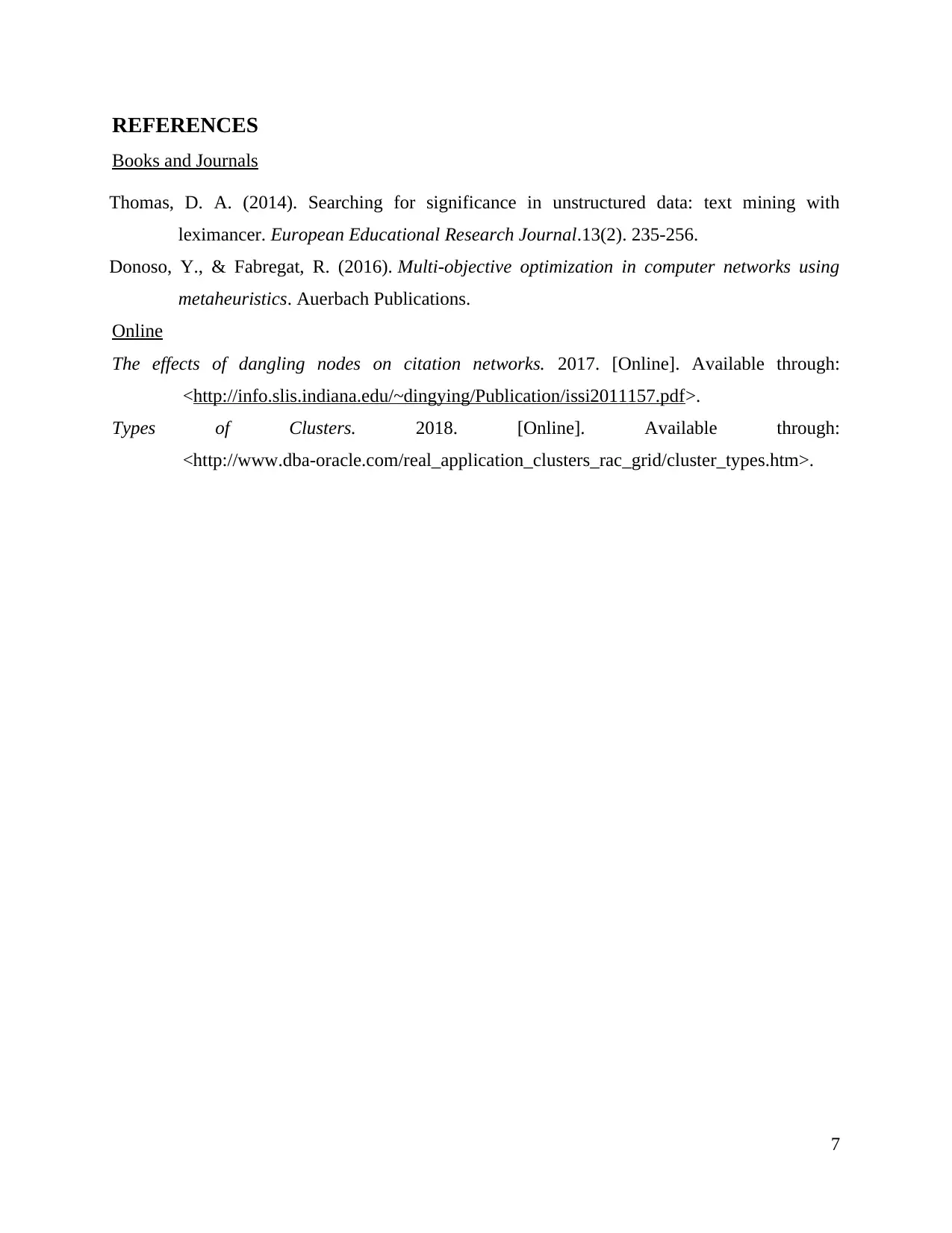
REFERENCES
Books and Journals
Thomas, D. A. (2014). Searching for significance in unstructured data: text mining with
leximancer. European Educational Research Journal.13(2). 235-256.
Donoso, Y., & Fabregat, R. (2016). Multi-objective optimization in computer networks using
metaheuristics. Auerbach Publications.
Online
The effects of dangling nodes on citation networks. 2017. [Online]. Available through:
<http://info.slis.indiana.edu/~dingying/Publication/issi2011157.pdf>.
Types of Clusters. 2018. [Online]. Available through:
<http://www.dba-oracle.com/real_application_clusters_rac_grid/cluster_types.htm>.
7
Books and Journals
Thomas, D. A. (2014). Searching for significance in unstructured data: text mining with
leximancer. European Educational Research Journal.13(2). 235-256.
Donoso, Y., & Fabregat, R. (2016). Multi-objective optimization in computer networks using
metaheuristics. Auerbach Publications.
Online
The effects of dangling nodes on citation networks. 2017. [Online]. Available through:
<http://info.slis.indiana.edu/~dingying/Publication/issi2011157.pdf>.
Types of Clusters. 2018. [Online]. Available through:
<http://www.dba-oracle.com/real_application_clusters_rac_grid/cluster_types.htm>.
7
Paraphrase This Document
Need a fresh take? Get an instant paraphrase of this document with our AI Paraphraser

APPENDIX
Scenario A
Scenario B
8
Scenario A
Scenario B
8
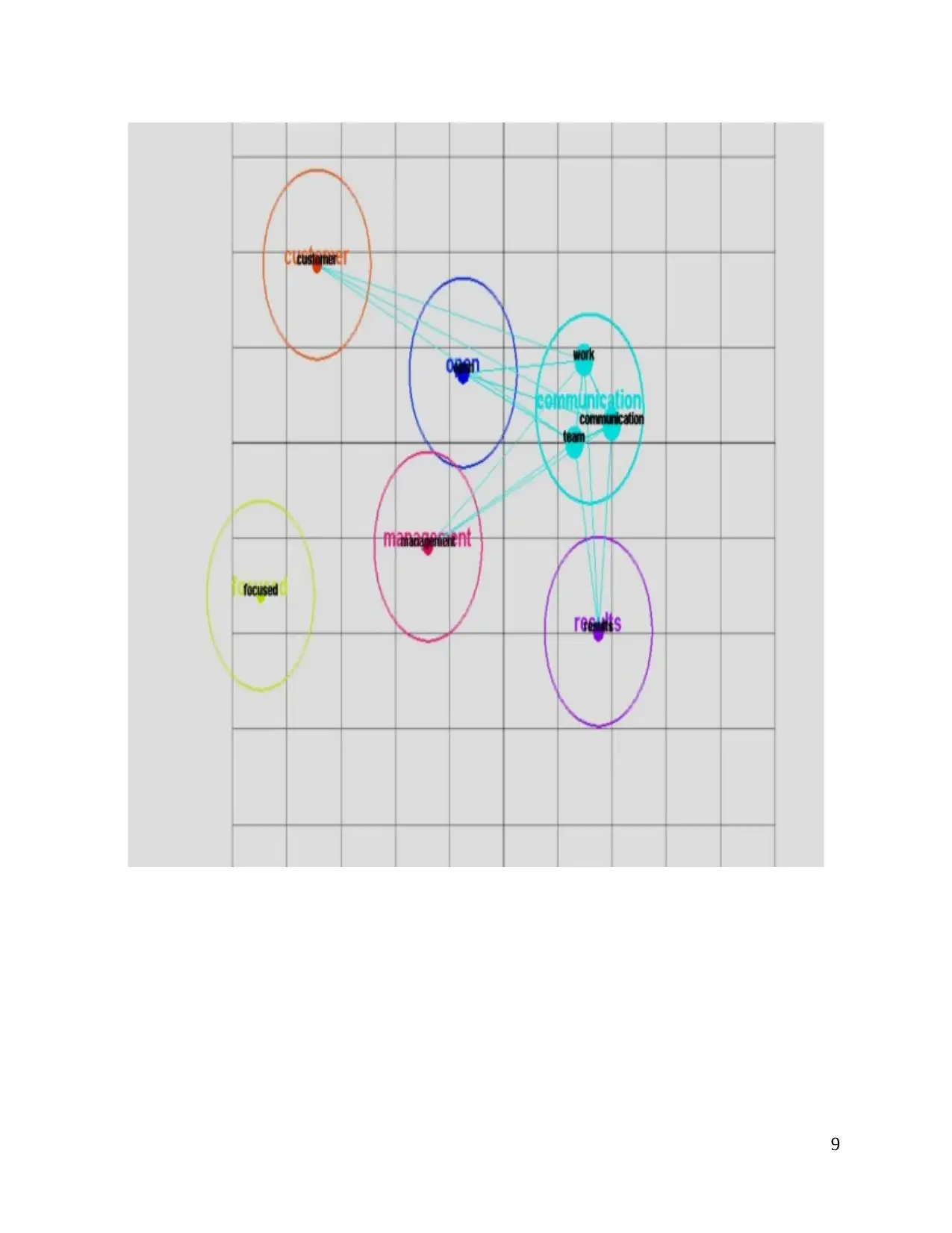
9
⊘ This is a preview!⊘
Do you want full access?
Subscribe today to unlock all pages.

Trusted by 1+ million students worldwide
1 out of 13
Related Documents
Your All-in-One AI-Powered Toolkit for Academic Success.
+13062052269
info@desklib.com
Available 24*7 on WhatsApp / Email
![[object Object]](/_next/static/media/star-bottom.7253800d.svg)
Unlock your academic potential
Copyright © 2020–2025 A2Z Services. All Rights Reserved. Developed and managed by ZUCOL.




